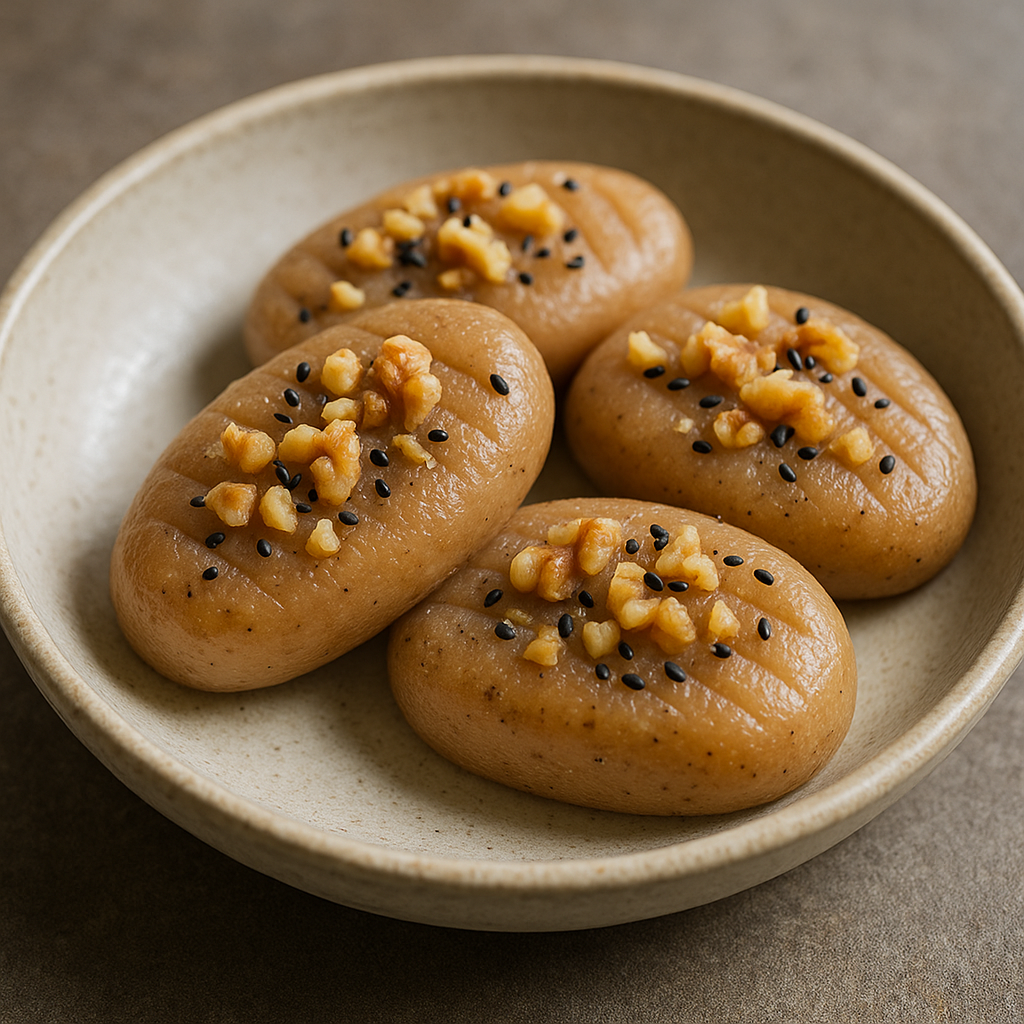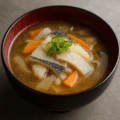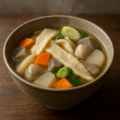きりせんしょの特徴
米粉×砂糖×醤油の生地にくるみ・ごまを合わせる素朴な郷土菓子
「きりせんしょ」は、うるち米の粉(上新粉)に砂糖と醤油を合わせ、くるみや黒ごまを混ぜて蒸し上げる岩手県央の伝統菓子。もっちりとした弾力に、香ばしいナッツの風味が映える飽きのこない一品です。家庭ごとに形や甘さの加減に個性があり、行事や“こびる(小昼)”のおやつとして親しまれてきました。
名称の由来
古くは“刻んだ山椒を浸した汁で粉をこねた(きりさんしょう)”ことに由来したと伝わり、言い回しが変化して「きりせんしょ」になったという説があります。現在は山椒を用いない配合が一般的です。
きりせんしょのレシピ
材料(作りやすい量/直径6〜7cm×12〜14個)
- 上新粉(うるち米粉)… 300g
- 砂糖 … 120g(黒砂糖80g+上白糖40g など好みで)
- 醤油 … 40ml
- 塩 … ひとつまみ
- 水 … 380〜420ml(生地の固さで加減)
- くるみ … 60g(軽く煎って粗みじん)
- 黒ごま … 大さじ1
- 打ち粉(片栗粉)… 適量
作り方
- 下準備:くるみはフライパンで軽くから煎りし、粗く刻む。
- 糖液を作る:鍋に水・砂糖・醤油・塩を入れて沸かし、火を止める。
- こねる:ボウルに上新粉・黒ごまを入れ、熱い糖液を一気に加えて木べらで手早く混ぜる。粗熱が取れたら手で耳たぶ程度のしっとり感になるまでこね、くるみを均一に混ぜる。
- 成形:打ち粉をした台で棒状にのばし、12〜14等分。丸めて小判形に整え、中央をやや厚めにする。
- 蒸す:蒸し器に濡らした蒸し布を敷き、生地を並べて強火で15〜20分蒸す。
- 仕上げ:取り出して粗熱を取り、好みで表面に黒ごまを少量のせる。温かいうちに、または冷ましてもしっとりして美味。
シェフのワンポイントアドバイス
- 生地はやわらかすぎないのがコツ。手離れが悪ければ上新粉を、固ければ湯(水)を少量ずつ加えて調整。
- くるみは焦がさない程度に煎ると香りが立ちます。黒砂糖を多めにするとコク深い味に。
- 翌日は軽く加熱する事でしっとり感が復活します。表面に醤油を薄く塗ってさっと蒸すと香ばしさが増します。
栄養価(1個あたり目安)
- エネルギー:150〜210 kcal
- たんぱく質:2〜4 g
- 脂質:4〜9 g(くるみ由来)
- 炭水化物:27〜35 g
歴史
米どころの“人寄せ菓子”
盛岡・花巻・紫波・遠野などを中心に、節句や人寄せの席、日々のこびるに作られてきた家庭の味。丸形や小判形、甘さやナッツの量など、家ごとのレシピが今も息づいています。
English Version
Features of Kirisensho
A simple regional sweet of rice flour, sugar, soy sauce, walnuts, and sesame
“Kirisensho” is a traditional confection from central Iwate made by kneading non-glutinous rice flour (jōshin-ko) with sugar and soy sauce, then mixing in walnuts and black sesame before steaming. The result is pleasantly chewy with toasty nut aromas. Shapes and sweetness vary by household, and it’s long been enjoyed at gatherings and as a small mid-day snack called kobiru.
Name origin
One theory traces the name to an older method of kneading the flour with liquid infused with finely chopped Japanese pepper (kiri sanshō), which over time shifted to “kirisensho.” Today, most recipes omit sanshō.
Recipe
Ingredients (makes 12–14 pieces, 6–7 cm each)
- Jōshin-ko (non-glutinous rice flour) … 300 g
- Sugar … 120 g (e.g., 80 g dark brown sugar + 40 g white sugar)
- Soy sauce … 40 ml
- Salt … a pinch
- Water … 380–420 ml (adjust for dough consistency)
- Walnuts … 60 g (lightly toasted, roughly chopped)
- Black sesame … 1 Tbsp
- Dusting starch (potato starch) … as needed
Instructions
- Prep nuts: Lightly toast the walnuts in a dry pan and chop roughly.
- Make syrup: In a saucepan, bring water, sugar, soy sauce, and salt just to a boil; turn off the heat.
- Knead: In a bowl, combine rice flour and black sesame. Pour the hot syrup in at once and mix quickly with a spatula. When cool enough to handle, knead by hand to a soft “earlobe” texture, then fold in the walnuts evenly.
- Shape: On a lightly dusted board, roll the dough into a log and divide into 12–14 pieces. Round each and flatten into small ovals, slightly thicker at the center.
- Steam: Line a steamer with a damp cloth, arrange the pieces, and steam over high heat for 15–20 minutes.
- Finish: Let cool briefly. Top with a few sesame seeds if you like. Tastes good warm or cooled—the texture stays moist.
Chef’s Tips
- Avoid an overly soft dough. If sticky, dust in a little more rice flour; if stiff, add hot water a teaspoon at a time.
- Toast walnuts gently to release aroma; more dark brown sugar gives deeper flavor.
- For the next day, lightly re-steam to restore moisture. Brushing the surface with a touch of soy sauce before a quick steam adds extra fragrance.
Nutritional Value (per piece, approx.)
- Calories: 150–210 kcal
- Protein: 2–4 g
- Fat: 4–9 g (from walnuts)
- Carbohydrates: 27–35 g
History
A “gathering sweet” from rice country
Centered around Morioka, Hanamaki, Shiwa, and Tōno, kirisensho has been made for festivals, family gatherings, and everyday kobiru. Shapes (round or oval), sweetness, and nut amounts vary—household traditions that continue today.



何でも質問してください!